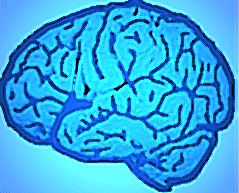
Neuroscience: A Journey Through the Brain
 |
Neuroscience: A Journey Through the Brain |
| Main Page Organization Development Neuron Systems About the site (Glossary) References |
The Major Systems: Motor Systems
The control of movement can be achieved at one of two levels: the spinal cord, or the brain.
Spinal Control of Movement (back to top)
Ever heard the expression "Running like a chicken with its head cut off"? Complex patterns of movement can be generated in the spinal cord, without descending input from higher brain centers.
Deep within skeletal muscles are receptors called muscle spindles. Sensory Ia axons wrap themselves around this spindle, and go on to form synapses with motor neurons and interneurons in the ventral horns of the spinal cord. This sensory input to the spinal cord allows feedback from muscles to modify the motor signals sent to them.
|
For example, the myotatic reflex occurs when a muscle contracts after being pulled on. If the sensory neurons are cut, this reflex does not occur. |
The muscle fibers inside the spindles are called intrafusal fibers, while the rest of the muscle fibers (which form the bulk of the muscle in the body) are called extrafusal fibers. Intrafusal fibers receive input from gamma motor neurons in the spinal cord. Activity in gamma motor neurons forms part of another feedback control loop to control contraction of muscles.
Also in skeletal muscles are Golgi tendon organs, which send activity back to the spinal cord via Ib sensory neurons. These sensory neurons form connections with inhibitory interneurons in the spinal cord to control reverse myotatic reflexes.
| For example, this reflex causes muscles to relax at a certain level of tension in the contractors, preventing overload of the muscle. Interneurons also generate flexor reflex and the crossed extensor reflex. The flexor reflex is used to withdraw your limb from an aversive stimulus. The crossed extensor reflex is used to compensate for the extra load imposed by limb withdrawal on anti-gravity muscles, such as those in the leg. |
Within the spinal cord are also contained circuits that give rise to rhythmic motor activity - central pattern generators. The circuit is not clearly established yet, but may involve steady input to two excitatory interneurons that connect to motor neurons controlling both flexion and extension.
Brain Control of Movement (back to top)
The central motor system is arranged as a hierarchy, normally split into three levels.
Descending Spinal Tracts (back to brain control) (back to top)
The brain needs to communicate with the spinal cord in order to control movement, and does so via two separate pathways.
The lateral pathway is involved in voluntary movement of distal musculature and is under direct cortical control. The lateral pathway involves two tracts: the corticospinal tract and the rubrospinal tract. The corticospinal tract originates in the motor cortex, which involves areas 4 and 6 of the cortex. Axons course through the midbrain and pons, and collect to form a tract in the medulla, where is decussates. This means that the right motor cortex control the left side of the body, and vice versa. The rubrospinal tract originates in the red nucleus of the midbrain, and have their point of decussation in the pons. These axons join the corticospinal tract in the lateral pathway in the spinal cord.
The ventromedial pathway contains four descending tracts involved in the control of posture and locomotion, and is under brainstem control.
| Tract | Location of origination | Function |
| Vestibulospinal | Vestibular nuclei of the medulla which relays sensory information to the inner ear (vestibular apparatus). | Keep the head balanced as the body moves, and turn the head towards new stimuli. |
| Tectospinal | Superior colliculus of the midbrain, which receives direct input from the retina | |
| Pontine reticulospinal | Pontine reticular formation | Enhances the anti-gravity reflexes in the spinal cord |
| Medullary reticulospinal | Medullary reticular formation | Liberate anti-gravity muscles from reflex control |
Planning of Movement by the Cerebral Cortex (back to brain control) (back to top)
There are several areas in the brain involved in planning and instruction of voluntary movement. These include:
Prefrotnal cortex
Supplementary motor area and Premotor area (Area 6)
M1 (Area 4)
S1
Posterior parietal cortex (Area 5 and 7)
The Basal Ganglia (back to brain control) (back to top)
|
The basal ganglia form the major inputs to the ventral lateral nucleus of the thalamus, which in turn provides major inputs to area 6, comprised of the PMA and SMA, The basal ganglia is a collection of subcortical nuclei including the following:
The pathways between the cortex and the basal ganglia can be illustrated as to the right: This pathway illustrates the connections between the Cerebral Cortex, the Basal Ganglia, and all of the Descending Spinal Tracts involved in the control of movement by the brain. |
|
Created and Maintained by: Melissa
Davies
Last Updated: April 10, 2002 09:10 AM